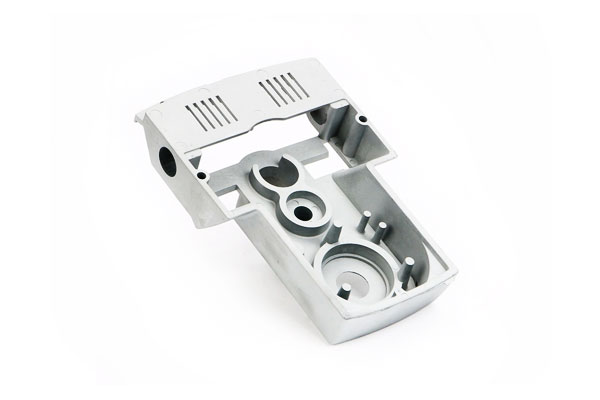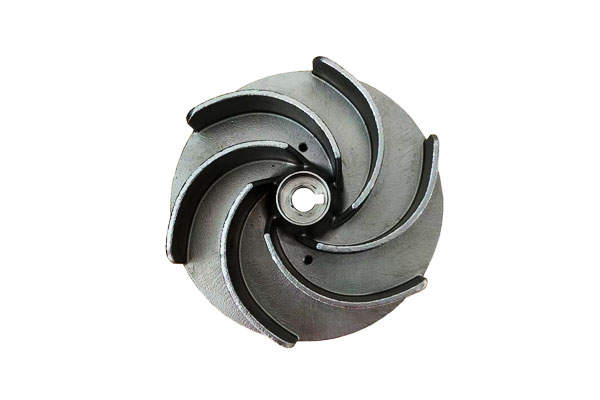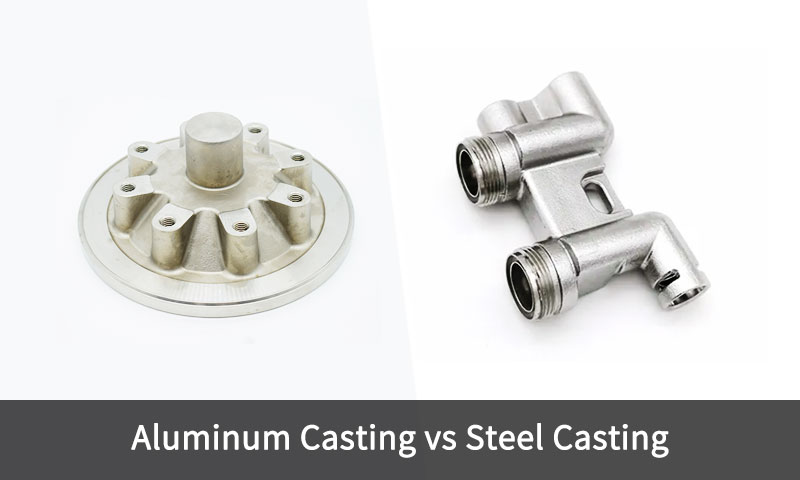1. Introduzzjoni
Aluminju vs Steel Casting - l-għażla bejn dawn iż-żewġ materjali fundamentali forom il-prestazzjoni tal-komponenti, l-ispiża u l-manifattura fl-industriji mill-karozzi għall-enerġija.
Dan il-paragun mhuwiex biss dwar il-kimika tal-metall: jiġbor id-densità u l-ebusija, imġieba termali, kompatibilità tal-proċess tal-ikkastjar, ipproċessar sekondarju (trattament tas-sħana, Inġinerija tal-wiċċ), l-ispiża taċ-ċiklu tal-ħajja u l-affidabbiltà speċifika għall-applikazzjoni.
L-inġiniera u x-xerrejja għandhom għalhekk jevalwaw is-sistema kollha—tagħbija, temperatura, ambjent, il-volum tal-produzzjoni u r-rekwiżiti tal-finitura — qabel ma tispeċifika rotta tal-metall u tal-ikkastjar.
2. Differenzi Materjali Fundamentali Bejn Aluminju vs Azzar
Fil-qalba tal-aluminju vs. ikkastjar tal-azzar jinsab kuntrast metallurġiku u fiżiku fundamentali li jaffettwa direttament kif kull materjal iġib ruħu waqt l-ikkastjar, magni, u servizz.
| Proprjetà | Aluminju (E.g., Al-i jtaffi) | Azzar (E.g., azzar tal-karbonju jew b'liga baxxa) | Implikazzjonijiet ta 'inġinerija |
| Densità (g / cm³) | 2.70 | 7.85 | L-aluminju huwa ~ 65% eħfef, li joffri iffrankar kbir ta 'piż għat-trasport u l-ajruspazju. |
| Punt ta 'tidwib (° C.) | 615–660 | 1425–1540 | Il-punt tat-tidwib baxx tal-aluminju jippermetti ikkastjar aktar faċli u konsum aktar baxx tal-enerġija; l-azzar jeħtieġ fran speċjalizzati. |
| Konduttività termali (W / m · k) | 120–180 | 40–60 | L-aluminju jxerred is-sħana b'mod effiċjenti—ideali għall-magni, Skambjaturi tas-sħana, u l-elettronika. |
| Saħħa speċifika (MPA/ρ) | ~100–150 | ~70–90 | Minkejja saħħa assoluta aktar baxxa, il-proporzjon tas-saħħa għall-piż tal-aluminju jaqbeż dak tal-azzar. |
| Modulu elastiku (GPA) | 70 | 200 | L-azzar huwa aktar iebes, jipprovdu riġidità aħjar taħt tagħbija u vibrazzjoni. |
Reżistenza għall-korrużjoni |
Eċċellenti (jifforma saff ta' Al₂O₃) | Varjabbli; suxxettibbli għas-sadid mingħajr kisjiet | L-aluminju jirreżisti l-ossidazzjoni b'mod naturali, filwaqt li l-azzar jeħtieġ protezzjoni tal-wiċċ (pittura, plating, jew liga b'Cr/Ni). |
| Makkinabilità | Eċċellenti | Moderat għal diffiċli | L-irtubija tal-aluminju tippermetti makkinar faċli u ħinijiet ta 'ċiklu iqsar; l-azzar jeħtieġ għodda aktar iebsa. |
| Riċiklamat | >90% rekuperabbli | >90% rekuperabbli | Iż-żewġ materjali huma riċiklabbli ħafna, għalkemm it-tidwib mill-ġdid tal-aluminju jeħtieġ inqas enerġija (5% tal-produzzjoni primarja). |
| Tixrob Inxtorob (%) | 1.3–1.6 | 2.0–2.6 | L-azzar jiċkien aktar waqt is-solidifikazzjoni, jesiġu kwoti akbar u sistemi ta' gating/tmigħ aktar kumplessi. |
| Spiża (appross., USD / kg) | 2.0–3.0 | 0.8–1.5 | L-aluminju jiswa aktar għal kull kilogramma, iżda l-iffrankar fil-piż u l-ipproċessar jista 'jibbilanċja l-ispejjeż totali taċ-ċiklu tal-ħajja. |
3. X'inhu Casting Aluminju?
Aluminju ikkastjar huwa l-proċess tat-tiswir ta 'aluminju mdewweb jew ligi ta' l-aluminju f'kumplessi, komponenti ta 'forma ta' qrib nett bl-użu ta 'forom.
Huwa wieħed mill-proċessi tal-ikkastjar tal-metall l-aktar użati globalment—jammonta għal aktar minn 50% tal-ikkastjar mhux tal-ħadid kollu—minħabba l-castability eċċellenti tal-aluminju, Densità baxxa, u reżistenza għall-korrużjoni.

Ħarsa ġenerali
Fl-ikkastjar tal-aluminju, aluminju mdewweb (tipikament bejn 680–750°C) jitferra jew injettat ġo kavità tal-moffa fejn jissolidifika fil-ġeometrija mixtieqa.
Il-punt tat-tidwib baxx tal-aluminju u l-fluwidità għolja jagħmluha ideali għat-tnejn metodi ta' produzzjoni tal-massa (bħal die casting) u Applikazzjonijiet ta 'preċiżjoni għolja (bħall-ikkastjar ta 'investiment).
Karatteristiċi ewlenin tal-Ikkastjar tal-Aluminju
- Proporzjon ta 'saħħa u piż għoli u għoli:
Ikkastjar tal-aluminju joffri prestazzjoni mekkanika eċċellenti filwaqt li jkun madwar terz il-piż tal-azzar. - Reżistenza tajba għall-korrużjoni:
Irqiq, awto-fejqan saff ta 'ossidu ta' l-aluminju (Al₂o₃) jipproteġi kontra l-ossidazzjoni u l-biċċa l-kbira tal-korrużjoni atmosferika jew tal-baħar. - Konduttività termali u elettrika eċċellenti:
Adattat għal applikazzjonijiet bħal Skambjaturi tas-sħana, housings, u komponenti elettriċi. - Riċiklamat:
L-aluminju jista 'jiġi riċiklat b'mod indefinit mingħajr degradazzjoni, tnaqqis tal-enerġija tal-produzzjoni sa 95% meta mqabbla mat-tidwib primarju.
Proċessi Komuni tal-Ikkastjar tal-Aluminju
| Metodu tal-ikkastjar | Deskrizzjoni | Applikazzjonijiet tipiċi |
| Die Casting | Injezzjoni bi pressjoni għolja ta 'aluminju mdewweb f'imut ta' l-azzar; rendimenti preċiżi, Partijiet b'ħitan irqaq. | Partijiet tal-karozzi (housings tal-irkaptu, parentesi), Elettronika għall-konsumatur. |
| Ikkastjar tar-ramel | Metall imdewweb jitferra f'forom tar-ramel; addattat għal akbar, partijiet ta’ volum aktar baxx. | Blokki tal-magna, manifolds, housings aerospazjali. |
| Casting ta' Investiment | Forom taċ-ċeramika minn mudelli tax-xama; ideali għal dettalji fini u tolleranzi stretti. | Komponenti tat-turbini aerospazjali, apparat mediku. |
| Ikkastjar permanenti tal-moffa | Forom tal-metall li jistgħu jerġgħu jintużaw; finitura tajba tal-wiċċ u kontroll dimensjonali. | Pistuni, roti, u komponenti tal-baħar. |
| Ikkastjar ċentrifugali | Juża forza ċentrifugali biex iqassam metall imdewweb; dens, Struttura ħielsa mid-difetti. | Tubi, kmiem, u ċrieki. |
Vantaġġi tal-ikkastjar tal-aluminju
- Ħafifa: Inaqqas il-piż tal-komponent bi 30–50% vs. azzar, it-titjib tal-effiċjenza tal-fjuwil (tal-karozzi) jew kapaċità tat-tagħbija (aerospazjali).
- Effiċjenza fl-enerġija: L-aluminju li jdub jeħtieġ 60–70% inqas enerġija milli l-azzar (570° C vs.. 1420° C.), jitbaxxew l-ispejjeż tal-ipproċessar billi 20–30%.
- Reżistenza għall-korrużjoni: Jelimina l-ħtieġa għall-kisi (E.g., żebgħa, galvanizzazzjoni) f'ħafna mill-ambjenti, tnaqqas l-ispejjeż tal-manutenzjoni billi 40–50%.
- Vijabilità ta 'Volum Għoli: Die casting jippermetti produzzjoni ta ' 1000+ partijiet/jum għal kull magna, tissodisfa d-domanda għall-oġġetti tal-konsumatur.
Żvantaġġi tal-Ikkastjar tal-Aluminju
- Qawwa aktar baxxa: Qawwa tat-tensjoni (150–400 MPa) huwa 50-70% inqas minn azzar ta 'saħħa għolja, jillimitaw l-użu f'applikazzjonijiet ta' tagħbija tqila.
- Prestazzjoni Fqira f'Temperatura Għolja: Iżomm biss 50% tas-saħħa tat-temperatura tal-kamra f'250°C, jagħmilha mhux adattata għall-egżost tal-magna jew komponenti tal-impjant tal-enerġija.
- Riskju tal-porożità: L-aluminju die-cast huwa suxxettibbli għall-porożità tal-gass (minn injezzjoni bi pressjoni għolja), jirrestrinġu l-għażliet tat-trattament tas-sħana (E.g., It-temper T6 jeħtieġ ipproċessar bil-vakwu).
- Spiża Ogħla tal-Materja Prima: Spejjeż tal-aluminju primarju $2,500–$3,500/tunnellata, 2–3x aktar mill-azzar tal-karbonju.
Applikazzjonijiet Industrijali tal-Ikkastjar tal-Aluminju
L-ikkastjar ta 'l-aluminju huwa użat ħafna f'diversi industriji minħabba l-kombinazzjoni tiegħu ta' Disinn ħafif, makkinabilità, u reżistenza għall-korrużjoni:
- Automotive: Blokki tal-magna, housings ta 'trasmissjoni, roti, u armi ta' sospensjoni.
- Aerospazjali: Parentesi, Fittings strutturali, Housings tal-kompressur.
- Elettronika: Sinkijiet tas-sħana, Housings bil-mutur, kompartimenti.
- Oġġetti għall-konsumatur: Apparat, Għodda tal-enerġija, ħardwer tal-għamara.
- Enerġija Marittima u Rinnovabbli: Skrejjen, housings, u xfafar tat-turbini.
4. X'inhu Steel Casting?
Ikkastjar tal-azzar huwa l-proċess li jitferra azzar imdewweb ġo moffa biex tipproduċi kumplessi, komponenti ta 'saħħa għolja li ma jistgħux jiġu fabbrikati jew falsifikati faċilment.
B'differenza mill-aluminju, azzar għandu a punt ta 'tidwib ogħla (≈ 1450–1530°C) u saħħa tat-tensjoni akbar, tagħmilha ideali għal applikazzjonijiet li jifilħu t-tagħbija u f'temperatura għolja bħal makkinarju, infrastruttura, u l-ġenerazzjoni tal-enerġija.

Ħarsa ġenerali
Fl-ikkastjar tal-azzar, azzar imdewweb b'liga b'attenzjoni jitferra' jew li jintefqu (ramel, investiment) jew forom permanenti, fejn tissolidifika f'forma qrib il-parti finali.
Minħabba li l-azzar jiċkien b'mod sinifikanti mat-tkessiħ, kontroll preċiż tat-temperatura, Disinn tal-gating, u l-immudellar tas-solidifikazzjoni huma kritiċi.
Ikkastjar ta 'l-azzar huma magħrufa għal tagħhom robustezza mekkanika, Reżistenza għall-impatt, u integrità strutturali, partikolarment taħt kundizzjonijiet ħorox ta’ servizz.
Karatteristiċi ewlenin tal-Ikkastjar tal-Azzar
- Qawwa Eċċezzjonali u Toughness:
Il-qawwiet tar-rendiment ħafna drabi jaqbżu 350 MPA, bil-ligi ittrattati bis-sħana li jilħqu 1000 MPA. - Kapaċità ta 'Temperatura Għolja:
Iżomm is-saħħa u r-reżistenza għall-ossidazzjoni sa 600–800°C, skond il-kompożizzjoni. - Għażla tal-Liga Versatili:
Jinkludi Azzar tal-karbonju, Azzar b'liga baxxa, Azzar li ma jissaddadx, u azzar b'ħafna manganiż, kull wieħed imfassal għal ambjenti speċifiċi. - Weldabilità u makkinabilità:
Azzar fondut jista 'jiġi pproċessat wara b'mod effettiv—makna, iwweldjat, u ttrattati bis-sħana biex itejbu l-prestazzjoni.
Proċessi Komuni tal-Ikkastjar tal-Azzar
| Metodu tal-ikkastjar | Deskrizzjoni | Applikazzjonijiet tipiċi |
| Ikkastjar tar-ramel | Azzar imdewweb jitferra f'forom tar-ramel magħqudin; ideali għal kbir, Partijiet kumplessi. | Korpi tal-valv, Kisi tal-pompa, djar tal-makkinarju. |
| Casting ta' Investiment | Forom taċ-ċeramika ffurmati minn mudelli tax-xama; jagħti preċiżjoni eċċellenti u finitura tal-wiċċ. | Xfafar tat-turbina, Għodda kirurġika, Partijiet aerospazjali. |
| Ikkastjar ċentrifugali | Il-forza rotazzjonali tqassam l-azzar imdewweb b'mod uniformi; jipproduċi komponenti ċilindriċi densi. | Pajpijiet, Liners, tiġrijiet li jġorru. |
| Tidwir tal-moffa tal-qoxra | Juża forom tar-ramel irqiq miksija bir-reżina; jippermetti preċiżjoni ogħla u uċuħ aktar lixxi. | Partijiet żgħar tal-magna, parentesi. |
| Ikkastjar kontinwu | Għal prodotti tal-azzar nofshom lesti bħal ċangaturi u billetti. | Materja prima għall-irrumblar u l-forġa. |
Vantaġġi tal-Ikkastjar tal-Azzar
- Saħħa superjuri & Ebusija: Qawwa tat-tensjoni (sa 1500 MPA) u l-impatt tal-ebusija (40–100 J) jagħmluha insostitwibbli għas-sigurtà strutturali (E.g., Komponenti tal-pont, Chassis tal-karozzi).
- Prestazzjoni ta 'temperatura għolja: Jopera b'mod affidabbli fuq 400–600 ° C. (vs. limitu ta '250 °C ta' l-aluminju), addattat għall-kisi tal-magni bil-ġett u l-bojlers tal-impjanti tal-enerġija.
- Spiża Baxxa tal-Materja Prima: Spejjeż tal-azzar tal-karbonju $800–$1200/tunnellata, 60–70% inqas mill-aluminju primarju.
- Reżistenza għall-ilbies: Azzar ittrattat bis-sħana (E.g., 4140) għandu ebusija tal-wiċċ sa 500 HB, tnaqqis tal-frekwenza ta ' sostituzzjoni fl-applikazzjonijiet li joborxu mill 50–70%.
Żvantaġġi tal-Ikkastjar tal-Azzar
- Piż Għoli: Id-densità 2.7x dik tal-aluminju żżid il-konsum tal-fjuwil (tal-karozzi) jew tagħbija strutturali (bini).
- Użu Għoli ta 'Enerġija: L-azzar li jdub jeħtieġ 25–30 MWh/tunnellata (vs. 5–7 MWh/tunnellata għall-aluminju), żieda fl-ispejjeż tal-ipproċessar billi 40–50%.
- Suxxettibilità tal-korrużjoni: L-azzar tal-karbonju sadid f'ambjenti niedja (rata ta 'korrużjoni: 0.5–1.0 mm / sena fl-isprej tal-melħ), jeħtieġu kisjiet (E.g., galvanizzazzjoni) li add $1.5–$2.5/kg għall-ispejjeż.
- Makkinabilità Fqira: L-ebusija teħtieġ għodod speċjalizzati, Żieda fil-ħin tal-magni bi 30–50% vs. aluminju.
Applikazzjonijiet Industrijali tal-Ikkastjar tal-Azzar
Ikkastjar ta 'l-azzar jiddomina l-industriji eżiġenti saħħa, Durabilità, u reżistenza għas-sħana:
- Kostruzzjoni & Minjieri: Snien tal-iskavatur, partijiet tal-crusher, links tal-binarji.
- Enerġija & Ġenerazzjoni tal-Enerġija: Kisi tat-turbini tal-fwar, Korpi tal-valv, Komponenti nukleari.
- Żejt & Gass: Irjus tat-tħaffir, valvoli tal-pipeline, manifolds.
- Trasport: Couplers tal-ferrovija, housings tal-irkaptu, blokki tal-magni heavy-duty.
- Aerospazjali & Difiża: Irkaptu tal-inżul, Fittings strutturali, komponenti tal-korazza.
5. Tqabbil komprensiv: Aluminju vs Azzar Casting
Proċess fit u parti ġeometrija
- B'ħitan irqaq, kumpless, Partijiet ta 'volum għoli: aluminju die casting huwa ottimali (HPDC).
- Kbir, tqil, partijiet li jifilħu t-tagħbija: azzar/grafita sferoidali (Dukes) ħadid u azzar fondut permezz tal-ikkastjar tar-ramel huma preferuti.
- Volum medju b'rekwiżiti ta 'integrità għolja: aluminju bi pressjoni baxxa jew azzar ikkastjar ta 'investiment skond il-ħtiġijiet ta' saħħa.
Prestazzjoni mekkanika & wara l-ipproċessar
- Trattament tas-sħana: azzar fondut jista 'jiġi mkessaħ & ittemprat biex tinkiseb saħħa u toughness għolja; il-ligi tal-aluminju għandhom rotot li jwebbsu l-età iżda jilħqu saħħiet massimi aktar baxxi.
- Inġinerija tal-wiċċ: aluminju faċilment anodizes; l-azzar jista 'jiġi nitrurat, karburizzat, induzzjoni mwebbsa jew miksija b'sustanzi iebsa (Ċeramika, Chrome iebes).
Sewwieqa tal-ispejjeż (kunsiderazzjonijiet tipiċi)
- Spiża tal-materjal għal kull kg: metall mhux maħdum tal-aluminju għandu tendenza li jkun pprezzat ogħla għal kull kg minn ruttam/azzar tal-ħadid, iżda parti massa tnaqqas l-ammont meħtieġ.
- Għodda: die casting imut huma għaljin (amortizzazzjoni inizjali għolja) iżda spiża baxxa għal kull parti fil-volumi >10k–100k; għodda tar-ramel huwa rħis iżda xogħol għal kull parti ogħla.
- Magni: magni tal-aluminju aktar malajr (rati ogħla ta’ tneħħija), xedd aktar baxx tal-għodda; l-azzar jeħtieġ għodda aktar diffiċli u aktar ħin tal-magni — tgħolli l-ispiża totali speċjalment għal lottijiet żgħar.
Manifattura & modi difetti
- Porożità: L-aluminju HPDC jista 'jiżviluppa porożità tal-gass u jinxtorob; permanenti-moffa u pressjoni baxxa jnaqqsu l-porożità.
Ikkastjar tal-azzar jista 'jsofri inklużjonijiet u segregazzjoni; tidwib ikkontrollat u post-HT inaqqsu d-difetti. - Kontroll dimensjonali: die cast aluminju jilħaq tolleranzi stretti (± 0.1–0.3 mm); It-tolleranzi tal-azzar fondut tar-ramel huma aktar laxki (±0.5–2 mm) mingħajr post-makkinar.
Ambjentali & ċiklu tal-ħajja
- Riċiklaġġ: iż-żewġ metalli huma riċiklabbli ħafna. L-aluminju riċiklat juża frazzjoni żgħira (~5–10%) tal-enerġija tat-tidwib primarju; l-azzar riċiklat għandu wkoll iffrankar kbir ta 'enerġija meta mqabbel mal-ħadid verġni.
- Użu-fażi: aluminju ħafif jista 'jnaqqas il-konsum tal-fjuwil fil-vetturi - benefiċċju ambjentali fil-livell tas-sistema.
Tabella: Aluminju vs Steel Casting — Tqabbil Tekniku Ewlenin
| Kategorija | Tidwib tal-aluminju | Ikkastjar tal-azzar |
| Densità (g / cm³) | ~2.70 | ~7.80 |
| Punt ta 'tidwib (° C. / ° F.) | 660° C. / 1220° F. | 1450–1530°C / 2640–2790°F |
| Saħħa (Tensjoni / Rendiment, MPA) | 130–350 / 70–250 (kif imfittex); sa 500 Wara trattament tas-sħana | 400–1200 / 250–1000 (Jiddependi fuq il-grad u t-trattament tas-sħana) |
| Ebusija (HB) | 30–120 | 120–400 |
| Modulu elastiku (GPA) | 70 | 200 |
| Konduttività termali (W / m · k) | 150–230 | 25–60 |
| Konduttività elettrika (% IACS) | 35–60 | 3–10 |
| Reżistenza għall-korrużjoni | Eċċellenti (saff ta 'ossidu naturali) | Varjabbli - teħtieġ liga (Cr, Fi, Mo) jew kisi |
| Reżistenza għall-ossidazzjoni (High-Temp) | Limitat (<250° C.) | Tajjeb għal eċċellenti (sa 800°C għal xi ligi) |
| Makkinabilità | Eċċellenti (artab, faċli biex tinqata') | Moderat għal fqir (aktar diffiċli, Abrasiva) |
| Kastabbiltà (Fluwidità & Jinxtorob) | Fluwidità għolja, jinxtorob baxx | Fluwidità aktar baxxa, jinxtorob ogħla - jeħtieġ gating preċiż |
| Vantaġġ tal-piż | ~ 65% eħfef mill-azzar | Tqil - adattat għal tagħbijiet strutturali |
Finitura tal-wiċċ |
Lixx, riproduzzjoni tajba tad-dettall | Uċuħ aktar ħorox; jista 'jkollhom bżonn makkinar jew shot blasting |
| Flessibilità tat-Trattament tas-Sħana | Eċċellenti (T6, T7 tempers) | Wiesa ' (ttremprar, Tkessiħ, ittemprar, Normalizzazzjoni) |
| Riċiklamat | >90% riċiklat b'mod effiċjenti | >90% riċiklabbli iżda teħtieġ enerġija ta 'tidwib mill-ġdid ogħla |
| Spiża tal-Produzzjoni | Enerġija aktar baxxa, Ħinijiet taċ-ċiklu aktar mgħaġġla | Spiża ogħla tat-tidwib u xedd tal-għodda |
| Tolleranzi tipiċi (mm) | ±0.25 sa ±0.5 (die casting); ±1.0 (ikkastjar tar-ramel) | ±0.5–1.5 skond il-proċess |
| Impronta Ambjentali | Baxx (speċjalment aluminju riċiklat) | Impronta ogħla ta' CO₂ u enerġija minħabba punt ta' tidwib għoli |
| Applikazzjonijiet tipiċi | Roti tal-Karozzi, housings, Partijiet aerospazjali, oġġetti għall-konsumatur | Valvi, turbini, makkinarju tqil, komponenti strutturali |
6. Konklużjoni
Ikkastjar ta 'l-aluminju u l-azzar isolvu problemi ta' inġinerija differenti.
Aluminju jeċċella fejn piż ħafif, Konduttività termali, kwalità tal-wiċċ u rati ta 'produzzjoni għolja materja.
Azzar (u ħadid fondut) jiddominaw fejn saħħa għolja, ebusija, Reżistenza għall-ilbies, toughness u prestazzjoni ta 'temperatura elevata huma meħtieġa.
Bilanċ tajjeb tal-għażla tal-materjal rekwiżiti funzjonali, spiża (ċiklu tal-ħajja totali), produttività u tlestija.
F'ħafna disinji moderni jidhru soluzzjonijiet ibridi (inserzjonijiet tal-azzar f'ikkastjar tal-aluminju, komponenti miksijin jew bimetalliċi) biex tisfrutta l-qawwiet taż-żewġ metalli.
FAQs
Li huwa aktar b'saħħtu: aluminju fondut jew azzar fondut?
L-azzar fondut huwa b'mod sinifikanti aktar b'saħħtu—l-azzar A216 WCB għandu saħħa tat-tensjoni ta ' 485 MPA, 67% ogħla mill-aluminju A356-T6 (290 MPA).
L-azzar għandu wkoll toughness ferm akbar u reżistenza għall-ilbies.
Jista ' l-aluminju fondut jissostitwixxi l-azzar fondut?
Biss f'applikazzjonijiet fejn it-tnaqqis tal-piż huwa prijoritizzat fuq is-saħħa (E.g., partijiet mhux strutturali tal-karozzi).
L-azzar huwa insostitwibbli għal tagħbija għolja, komponenti ta 'temperatura għolja (E.g., Kisi tat-turbina).
Li huwa aktar reżistenti għall-korrużjoni: aluminju fondut jew azzar fondut?
L-aluminju fondut huwa aktar reżistenti għall-korrużjoni f'ħafna ambjenti (rata ta 'korrużjoni <0.1 mm / sena) vs. azzar tal-karbonju (0.5–1.0 mm / sena).
L-ikkastjar ta 'l-istainless steel jaqblu mar-reżistenza għall-korrużjoni ta' l-aluminju iżda jiswew 2-3x aktar.
Liema proċess ta 'ikkastjar huwa l-aħjar għall-aluminju vs. azzar?
L-aluminju huwa ideali għad-die casting (Volum għoli) u l-ikkastjar tar-ramel (spiża baxxa).
L-azzar huwa l-aħjar għall-ikkastjar tar-ramel (Partijiet kbar) u l-ikkastjar tal-investiment (kumpless, komponenti ta 'tolleranza għolja). Die casting rarament jintuża għall-azzar.


